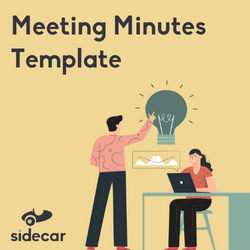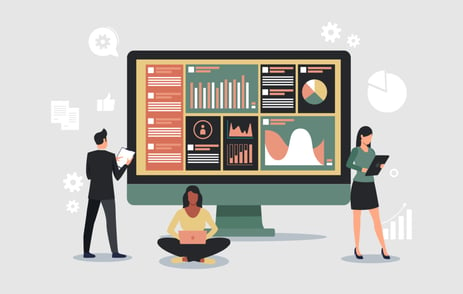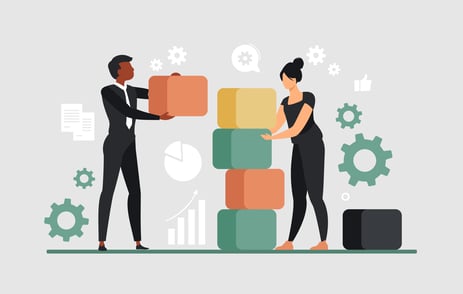When it comes to technology, nothing stays the same for too long. Tools and processes alike become obsolete and replaced with new ones – then the cycle repeats.
In recent years, one of the most groundbreaking technologies to emerge is blockchain. Although tech doesn't always pair well with other disciplines, in this case, we’re seeing the opportunity for a commensalistic relationship for associations.
Initially created to support cryptocurrency, blockchain is a distributed database that allows for secure, transparent, and tamper-proof transactions. Because it provides a breadth of possibilities to an equally large pool of unique problems, blockchain is definitely not a one-size-fits-all solution. It requires some finessing to fit each case just right, but if done correctly, it's an innovation that can change the way everyone operates.
5 Potential Blockchain Applications in Associations
The distributed ledger system that lies beneath blockchain technology provides a secure, sturdy foundation for verifying transactions, protecting data, and streamlining processes. With immutable records that are visible to stakeholders, it can ensure that all members of the association maintain the same level of trust without having to rely on a third party.
From tracking membership information more quickly and accurately to forming instantly-enforceable contracts in a fraction of the time it takes using traditional methods, internal procedures can be optimized faster and easier than ever before.
1. Tracking membership renewals and payments
Between keeping track of renewals and collecting payments, it can be overwhelming to manage all the data associated with memberships. That's where blockchain comes in. By using a decentralized digital ledger, memberships and payments can be tracked and managed without requiring any manual intervention.
Blockchain technology makes it possible to securely store and back up membership data, eliminating the need for paperwork or other manual processes. Plus, since multiple users have access to the same database, there's no risk of incorrect or missing entries, making it easy to keep track of critical member details quickly and accurately – all while reducing administrative costs along the way.
2. Recording meeting minutes and votes
Like a digital ledger, blockchain records every single transaction on its distributed network, so it can also be used to record something routine (like daily meeting minutes) or more infrequent (like election votes).
It provides users with highly secure data storage, so everything remains encrypted and protected from prying eyes. And because the data is stored over the distributed network instead of one central server, it entirely eliminates the possibility of vote tampering or corruption.

Meeting Minutes Template
When it comes to technology, nothing stays the same for too long. Tools and processes alike become obsolete and replaced with new ones – then the cycle repeats. In recent...
Download Now
3. Tracking donations and grants
Keeping track of donations and grants is crucial, but it can also be tricky. Donations are often made from multiple sources, and depending on the size of your association, it can be difficult to track them all. Fortunately, blockchain uses cryptographic protections like trusted timestamping and searchable encryption, so you can rest easy knowing all your transactions will be accurately timestamped and easily searchable.
Donations and grants can be organized quickly and transparently. And since every transaction is recorded on the ledger, there’s instant accountability and an integrated auditable trail for all transactions.
4 . Managing online forums and discussion boards
By encoding users’ digital identities in the blockchain ledger, administrators can easily identify users and track their activity over time, protecting against malicious activity and guarding against impersonation or disruption of dialogue.
Members can confidently participate in trusted exchanges without worrying about censorship while association leaders have greater oversight into the kinds of content being shared on their platforms. Blockchain allows leaders to approve new posts before they are published, allowing them to make sure all conversations stay constructive and useful while avoiding the dissemination of false information or scam attempts.
5. Recording certifications and qualifications
With certification data stored on the blockchain, it becomes much easier to verify qualifications instantly online. Every certification is cryptographically sealed, enhancing its reliability in the eyes of employers and other interested parties.
These benefits are two-fold: Credible people can quickly and easily demonstrate their credentials while it becomes more challenging for fraudulent actors to forge documents. At its core, this technology can provide organizations with a trusted way to verify credentials quickly and securely without paperwork or manual reviews.
See it in Action
The potential applications may sound avant-garde, but associations around the globe have already begun leveraging blockchain technology to better serve their communities.
World Food Program
The World Food Program (WFP) is increasingly delivering refugee assistance in the form of cash transfers. To make these transfers more efficient, transparent, and secure, they’ve been trialing blockchain technology. This blockchain-based (aka Building Blocks) system is integrated with UNHCR’s biometric authentication technology that allows refugees to identify themselves at the local supermarkets using cameras placed at the cash register. And as of October 2018, more than 100,000 Syrian refugees residing in camps have been successfully using this to redeem their cash-for-food assistance.
Alice Funding Platform
The first live project on the Alice funding platform was a pilot run by a UK homelessness charity, St Mungo’s, to help homeless people in London rebuild their lives. Upon ramping up, Alice decided to integrate blockchain smart contracts to increase the transparency and accountability of each donation. Essentially, this works by accepting but ‘freezing’ donations until the charity proves they have achieved the proper social goals. That way, donations are guaranteed to make an impact or donors will be able to get their money back.
Amply
Amply is a school subsidies platform enabling school teachers to digitally capture the school attendance records required to get subsidies from the government. The first iteration of the Amply mobile app enabled schools to automatically gather their attendance data and submit it to the Department of Social Development using blockchain infrastructure and smart contracts.
AIDChain
AIDChain is developing multiple blockchain-based solutions to make donations trackable and efficient in charity. Using AidPay, AIDChain’s payment gateway, charity websites can accept donations in 23 different cryptocurrencies in a similar way to how they currently accept donations using credit cards and PayPal. To take this even further, AIDChain has also issued its own cryptocurrency token called AidCoin.
How Association Pros Can Lead the Pack
Believe it or not, blockchain is inherently community-first. It provides opportunities for ultra-low-cost financial services, which can improve the reach, scale, and productivity of capital in the most challenging places and for the most underserved communities. The ethos and technical implementations of decentralization, democratic governance, and transparency built into blockchain technology can empower donors, members, and employees with new, transparent, democratic organizational tools and structures.
Blockchain can impact everything from fundraising, programs, and finance all the way to governance; we just have to understand how to best leverage it for our pain points. But while hurdles remain, the potential for impacting associations with a new level of trust and transparency in operations is promising. With more people becoming aware of blockchain every day, now may be the time to start investigating how it can help your association achieve its goals.
Tags:
Association Management
December 11, 2022


